Traditional Uttarakhand Weddings are known for their distinctive and romantic conjugal ceremonies.
Although the different ceremonies and traditions before, during, and after the wedding are extremely elaborate, the Kumaoni or Garhwali weddings of the ethnic communities in Uttarakhand are very simple.
These ceremonies capture the essence of the state‘s rich cultural fabric, melding both simplicity and grandeur in a breathtaking tableau. Whether it’s a Kumaoni or Garhwali wedding, representing the major ethnic communities of Uttarakhand, the approach to marital bliss is elegantly straightforward, yet steeped in elaborate customs and traditions.
From pre-wedding rituals to post-wedding celebrations, each aspect is meticulously curated, reflecting a lifestyle deeply rooted in heritage and community values. So come, explore the lesser-known, but profoundly beautiful, nuptial practices of Uttarakhand—a symphony of culture, love, and unity.
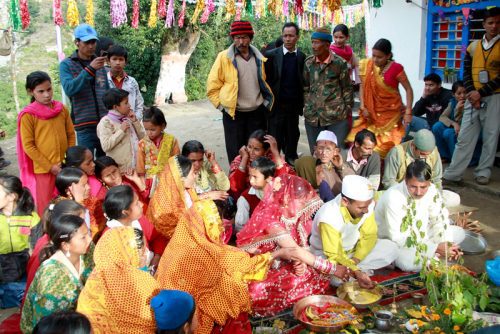
Pre-Wedding Rituals
Engagement
Kumaoni marriages, like other weddings, include an engagement ritual that is considerably different from others. Instead of the bride and groom, the dads of the soon-to-be-married pair exchange rings.
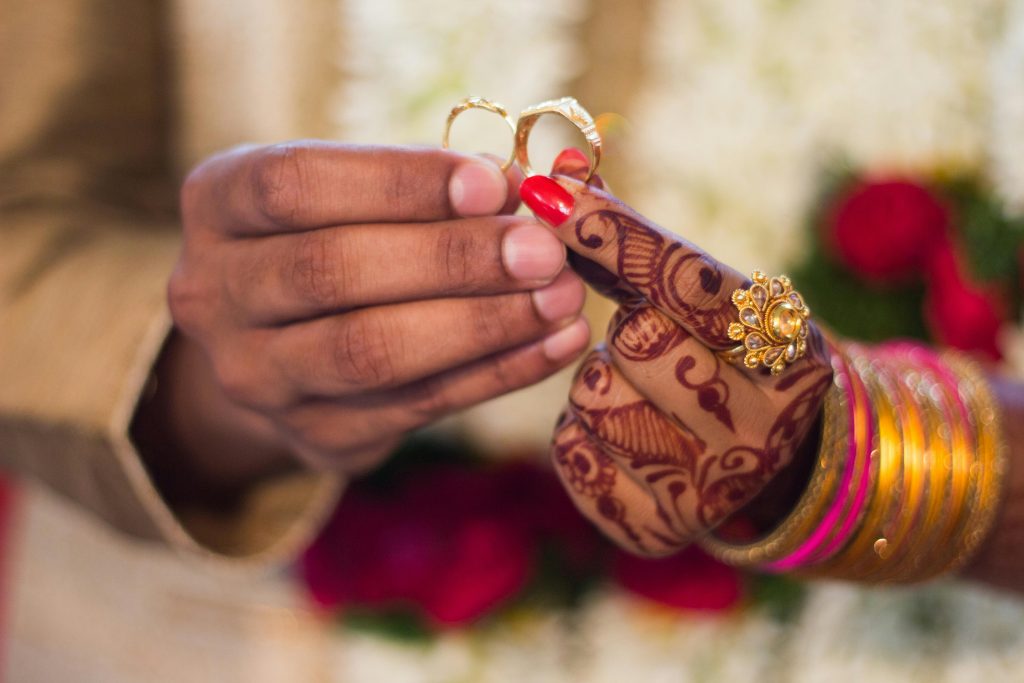
Image Credit: Kumar Saurabh via pexels
Mehendi ceremony
The Mehendi ceremony, in which henna is applied on the bride’s hands and feet, follows the engagement. Both parties participate in the Mehendi ritual. The bride has a composed entirely henna pattern applied to her hands, arms, and feet. The groom opts for a basic yet understated henna design that adorns his hands.
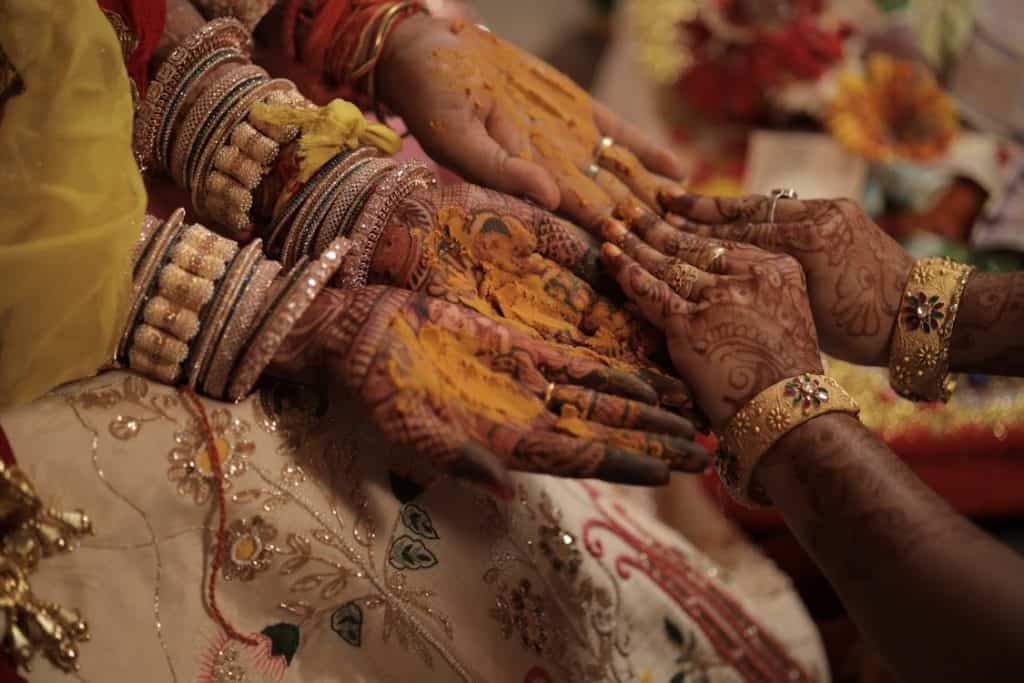
Image Credit: pexels
Wedding Rituals
Ganesh Puja
Even before the start of the wedding festivities, the bride and groom’s families appeal to Lord Ganesha for the ceremonies to be performed without any difficulties. The Ganesh me doob dharan is the name for this. Following that, the proper rites begin. After aabdev purvanga, ganesh puja, matrika puja, nandishradh, punanahavachan, kalash sthapan, and Navagraha pooja, the main lamp, or pradhaan diya, is lit.
In addition to these ceremonies, the bride and groom are smeared with turmeric or haldi by family members, and then they take a ceremonial bath. A bracelet in the shape of a little bale is wrapped around the hands of the woman, with betelnut and coins inserted in a yellow-coloured piece of cloth.
Suwal Pathai
This one-of-a-kind Kumaoni wedding tradition involves kneading wheat flour into dough and rolling it into circles. After immersing it in dry flour, it is dried in the sun. They are deep-fried after drying and presented to the gods as a Prasada.
Duliagarh
Once the groom’s party arrives at the bride’s door in the evening, unmarried girls greet them with pots full of water or kalash on their heads. The groom is carried and taken to the courtyard’s Dhuliarghay chauki, which is built of red clay and biswar rice flour. Numerous symbols such as kamal, kalash, shankh, chakra, and gada are included in this geometrical pattern.
Two chaukis (wooden stools) are set on top of this. The groom and the priest are expected to stand respectfully on these chaukis. The groom, or var, is revered as a manifestation of Vishnu. The daughter’s father applies tilak and distributes gifts like as money and clothes after cleaning the feet of var and aacharya.
Varmaala
This is essentially a garlands-exchanging ceremony that takes place after Duliagarh, when the groom advances to the centre stage. The bride joins him immediately after he takes his seat. The bride and groom’s family and a few close friends also join them on stage for this momentous occasion. The couple exchanges the Jai Mala, and the crowd applauds them with a round of applause, as well as a few pleasant jokes and giggles.
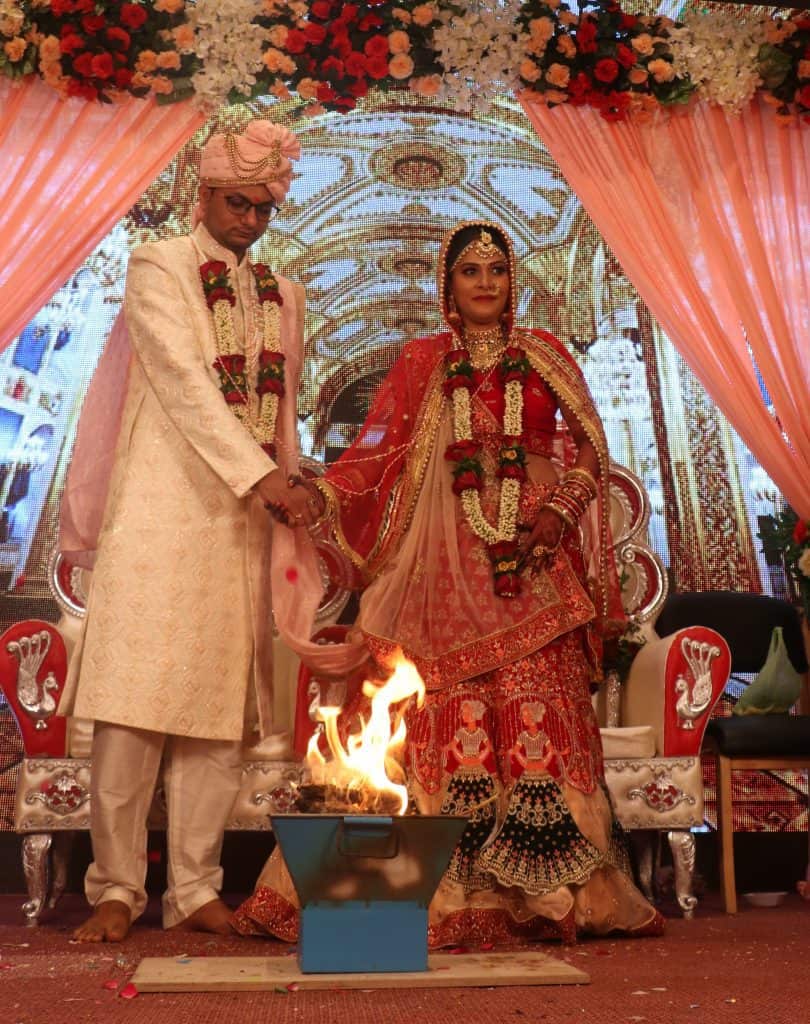
Image Credit: Wikimedia Commons
Kanyadaan
After the social formalities are completed, the priest takes over and performs a number of sacred rituals and ceremonies as prescribed by the ‘lagna’ (the positioning of the stars according to the horoscope of the bride and groom). This ceremony normally lasts a few hours and lasts all night until morning.
The bride’s father and mother next perform the emotive and most essential ritual, the ‘Kanyadaan.’ On this day, the bride’s parents conduct a fast. Kanyadaan is regarded as the most significant donation that anyone can give. The bride becomes a lifelong member of the groom’s family and his better half after performing the ritual.
Saptapadi
The bride and groom make seven rounds around the holy fire as a symbol of their devotion to one other in this ritual. To demonstrate their unity, the husband leads the bride in four rounds around the sacred fire, and then the bride takes over and does three circles. The bride and groom are pronounced husband and wife when this procedure is completed.
Vidai
Finally, the Vidai ritual takes place, during which the bride’s family bids their precious daughter farewell. The bride, as well as her family and friends, are feeling mixed emotions as she prepares to go to her husband’s house and leave her parents behind.
Post-Wedding Rituals
The Bride’s Welcome and Formal Introduction – The bride is greeted by her mother-in-law or the groom’s elder sister when she arrives at the groom’s house. All members of the family and their relatives are properly introduced to the new bride. Also, she is given an outline of her upcoming role and obligations.
After all of these procedures and rituals are accomplished, the bride and other female family members proceed to a water spring (called naula or dhara) bearing an urn of water or kalash on their heads. She then submerges in the water all of the things used in the puja rites.
Wedding Attire
A dhoti-kurta, sherwani, or formal suit is suitable for the groom’s attire.
The traditional Kumaoni or Garhwali bride would wear a traditional ‘Ghagri,’ which is a skirt-like garment similar to the ghaghra, along with a ‘choli,’ (the blouse), and a traditional ‘Pichora,’ which is also known as ‘Rangwali,’ and is a traditional ‘odhni,’ or veil, that is accessorised with silver and gold tatting.
The less traditional Uttarakhand bride, on the other hand, prefers to wear a saree instead of the ghagri-pichora.
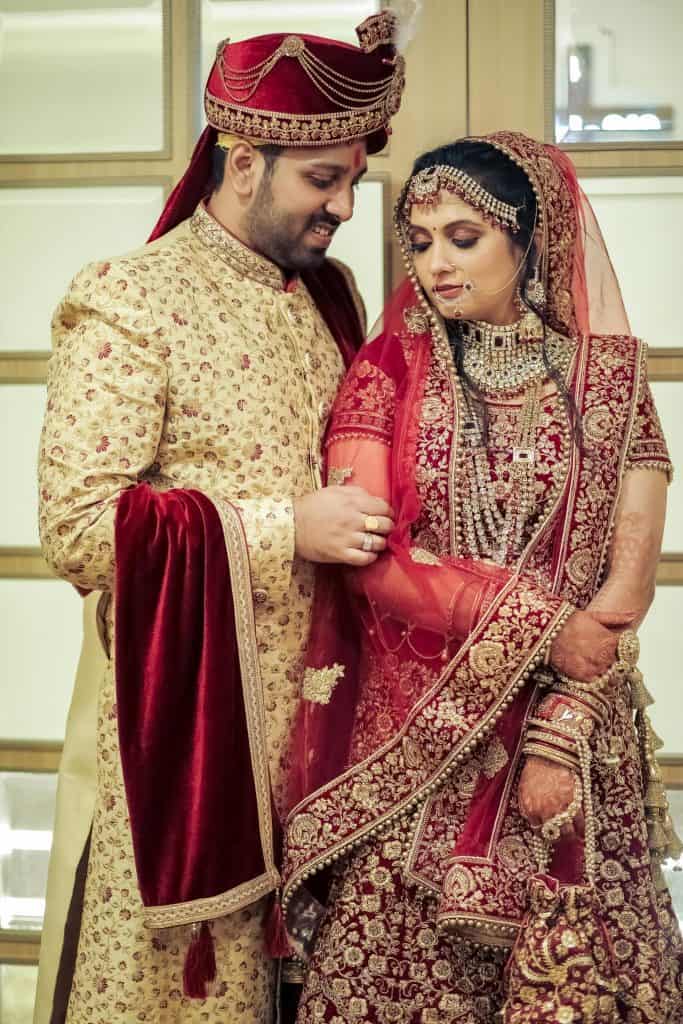
Image Credit: Pexels
Traditional Wedding Food
In a traditional Uttarakhand Wedding, the food served reflects the rich culinary heritage of the region. A simple yet delicious feast that balances both flavour and nutrition, the menu often features local and seasonal ingredients. Among the must-try dishes are ‘Aloo Ke Gutke,’ a spicy potato preparation, and ‘Gahat Ki Dal,’ a unique lentil dish often served with rice. No meal is complete without ‘Kumaoni Raita,’ a yoghurt-based accompaniment flavoured with turmeric and mustard. ‘Jhangora Ki Kheer,’ a dessert made from a local variety of millet, provides a sweet ending to the lavish spread.
For those with a taste for non-vegetarian cuisine, ‘Kumaoni Chicken Curry’ is often the star of the show. This culinary repertoire not only tantalizes the taste buds but also provides a window into the rich, agrarian lifestyle that defines Uttarakhand. It’s a feast that complements the grandeur of the wedding rituals, adding another layer of cultural richness to these extraordinary celebrations.
Garhwali and Kumaoni cuisines, two of Uttarakhand’s primary regions, dominate the traditional wedding cuisine. Simple, locally grown ingredients are used in the meals, which are not overpowered by complicated spices. Lentils are used in some of Uttarakhand’s most famous meals, which are cooked over low heat.
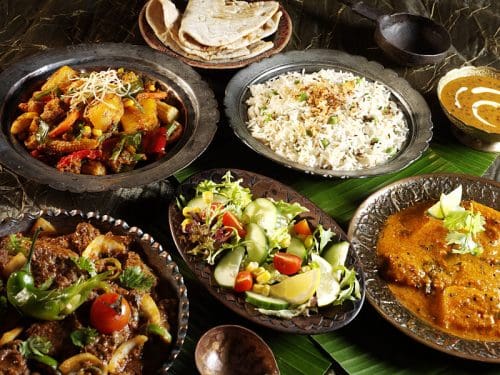
Image Credit: Mohans1995, CC BY-SA 4.0 via Wikimedia Commons
Kafuli
Kafuli is a popular Uttarakhand dish made with spinach and fenugreek leaves. This unusual cuisine is served with hot steaming rice and cooked in an iron kadhai.
Phaanu
Phaanu is a meal that is popular in Uttarakhand’s Garhwal region. It’s a little tricky to make because it’s produced by combining lentils of various sorts that have been soaked in water overnight. It’s a soupy dish that’s usually served with rice.
Kandalee Ka Saag
Kandalee Ka Saag is a quintessential dish that graces the tables at traditional Uttarakhand weddings. Made from a unique variety of leafy greens native to the Himalayan region, this dish is a testament to the state’s rich biodiversity. Delicately spiced and slow-cooked to perfection, Kandalee Ka Saag is not just a culinary delight but also a symbol of the local culture.
Dubuk
Dubuk, hailed as one of Uttarakhand’s best meals, enchants diners with its incomparable flavour. It’s a Dal recipe that’s best eaten with rice. You might be wondering what makes a simple Dal dish so remarkable. This comforting stew-like concoction is made primarily from lentils and local beans, infused with an array of indigenous spices and herbs. Slow-cooked to rich, earthy perfection, Dubuk is not just a meal but an experience that speaks to the region’s deep-rooted connection to the land. It is often served with rice or roti and embodies the warm, homely hospitality that Uttarakhand is renowned for.
Jhangora Ki Kheer
This is one of Uttarakhand’s most well-known sweet dishes. Made from Jhangora, a type of barnyard millet that is indigenous to the region, this kheer is a creamy, rich delicacy that’s steeped in cultural significance. Infused with aromatic cardamom and often garnished with a sprinkle of chopped nuts, it serves as the perfect conclusion to a hearty meal.

Its velvety texture and subtly sweet flavour make Jhangora Ki Kheer not just a dessert, but a celebration of Uttarakhand’s agricultural heritage and culinary ingenuity.
Enchanting World of Traditional Uttarakhand Weddings
The nuanced rituals continue to breathe life into these ceremonies. The pre-wedding festivities begin with ‘Ganesh Puja,’ invoking blessings for a new beginning. The main wedding ceremony features the ‘Pheras,’ where the couple circles the holy fire seven times, each round signifying a unique marital vow.
Interestingly, even the post-wedding customs, like ‘Bidai’ and ‘Gruh Pravesh,’ serve as a poetic conclusion to the nuptial chapter, each symbolizing a transition into new roles and responsibilities. The wedding ceremony remains a spiritual and cultural odyssey that cements the sanctity of marriage while celebrating the vibrant hues of Uttarakhand’s heritage.
The traditional Uttarakhand wedding goes beyond an event to a multi-generational celebration that brings families, communities, and even entire villages together. It encapsulates a unique blend of simplicity and profundity, making it an emblematic representation of Uttarakhand’s diverse yet unified cultural tapestry.
Read more: Latest



